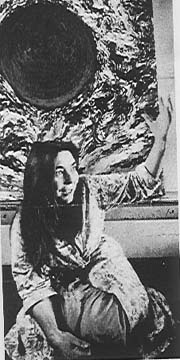|
|
||||||
|
Newsweek |
||||||
| MAY 19, 1969 | ||||||
| Art and Sanity Buried in the back streets of east London sits Kingsley Hall, a dingy, ramshackle building with peeling paint and broken windows. Inside, up a darkened stairwell, there is a tiny room cluttered with dolls, stuffed animals and children's books. It is here that 46?year?old Mary Barnes lived and it is here that she suffered several years of mental torment that reduced her to the state of infancy. In this same room Miss Barnes made her recovery with the help of two psychiatrists, Dr. Ronald D. Laing, the famed non?Freudian author of "Divided Self," and Dr. Joseph H. Berke, both directors of the Kingsley Hall mental health center. She overcame her madness not on a couch but by painting furiously?on paper, doors, window glass, old boards, canvas and even on the walls. 1t was the way she could communicate with other people and the way she could allow herself to be nourished," says Dr. Berke. |
|
|||||
|
Mary Barnes: A way of coping |
||||||
| Swirling: Twenty?one of Miss Barnes's works recently went on display in the
Camden Arts Center in the London borough of Hampstead. They have received laudatory notices from critics and are
selling for as much as $720 apiece. Ablaze with bold, brash, heavy strokes in vivid colours, lush landscapes and
religious scenes seem to document her madness from inside out. Before backgrounds of flaming suns, rugged mountains
and swirling clouds, paintings like "Time of the Tomb", a typical Barnes work, writhe with twisted trees
and contorted crucifix figures with heads turned painfully aside and mouths shrieking desperation. In other works
there are purple fetal creatures and blurry scatterings of semi?human figures on fields of red and gold. "Her
art represents her innocence, her fall, her crucifixion and her redemption," says Berke. "She had been
crucified all her life by her family and the people she worked with." Miss Barnes has always been dangerously close to madness. Born and reared in Hampshire, she recalls that when he was a teen?ager her brother was committed to a mental hospital. "We accepted it," she says, "and we considered that the rest of us were all right and that only Peter was mad." Some twenty years later Miss Barnes, a nurse, went to work in a nursing home for mental patients. I saw it around me," she says, "but I didn't know 1 was in the same situation as the patients were." In 1951 she herself suffered a breakdown and spent a terrifying, withdrawn year in a conventional mental hospital. 'There were rows of terribly crowded beds, doors always locked," she recalls with a shudder. 1 withdrew in every way. I would lie in the corner on the floor. I never wanted to move but, if they made me move, to put me in a bath of warm water maybe, I never wanted to come out of the warm water." Fears: When Miss Barnes left the hospital, she tried to suppress her fears and madness by working very hard on farms and in hospitals. After a dozen years of this, she heard that Laing and Berke were opening Kingsley Hall, where patients live, as they want to, without drugs and shock treatment. She entered in 1965 and she let her breakdown run its course, playing children's games and wearing nothing but boys' trousers." And, she recalled: "I got a box in the basement. For me it was a womb. I went down there, took my dolls, and lay in the box. I didn't want to do anything." Then, one day, Berke happened to give her a set of grease crayons and told her to scribble something. She scribbled and scribbled and finally pictures began to emerge. "Once I saw a woman with a baby," she says. I went and got some paint from the roof, left over from decorating. I got old pieces of wallpaper and painted furiously. They were all fetal pictures, or moving things, and I called them things like 'Baby'." Painting mostly with one finger, Miss Barnes has not only found success with London art critics, but also a way of coping with life. But for the moment, at least, she will stay at Kingsley Hall, painting and finishing work on a book about her life and her madness. She also works with other people in Kingsley Hall. "She hasn't stopped suffering," says Berke, "but she is able to reconcile her suffering." For Miss Barnes, Kingsley Hall is a "place where I can be understood and where I can be whole. I feel," she says, "that what is important in life is being as near whole as you can. The King of Heaven is within you and you have to be within the life you have". |
||||||
|
Newsweek, May 19, 1969 |
||||||

